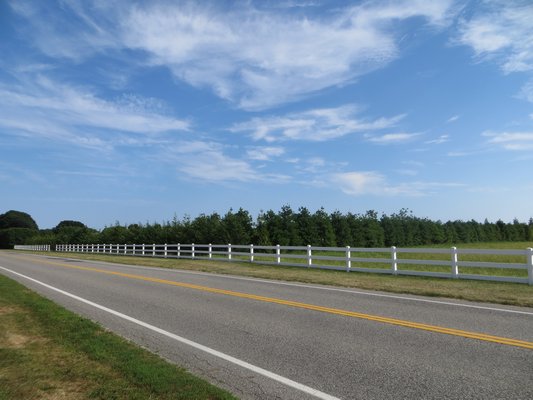
As the county’s farmland preservation program comes under fire, traditional growers are finding themselves in a unique position: defending sectors of the agricultural industry that they might not have considered to be on their team. “It is very difficult for farmers. We understand that horse farms are agriculture, but sometimes you feel like you’re dealing with culture shock,” said Marilee Foster, a Sagaponack vegetable grower. “I grew up riding horses, but they were in my backyard. And they didn’t cost upwards of a million dollars.”
With a laugh, she added, “I wish I had a vegetable that cost that much.”
“It is a touchy subject,” said Adam Halsey, a Water Mill grower whose land borders Bridgehampton horse country. “They are doing what’s allowed by New York State Ag and Markets. It is just a change from what is typical Long Island agriculture.”
The so-called “Ag and Markets,” or Agriculture and Markets Law 301, defines what is considered to be agriculture by the state. Nearly all the local and county laws that protect farmland use this definition, which includes livestock products, aquaculture and nursery stock. Since agriculture is a very different kind of business that relies on seasons and weather patterns and the availability of space, the law works to protect and encourage one of the state’s leading sectors.
However, this broad definition has had some unintended consequences over the years. By including crops with high profit margins like nursery stock, it makes it difficult for food producers to compete. Between 1998 and 2016, field crops went down 26 percent in Southampton Town, according to the Peconic Land Trust. In the same time period, equestrian use increased 15 percent and nursery stock increased 44 percent.
“Every time a new horse farm appears, that is land that will likely never return to food production. In the way, yes there is a competition for resources, that resource being agriculture land,” said David Falkowksi, an organic vegetable farmer. “I wouldn’t say I’m competing with horse farms. I’m competing with the people with the most money.”
In an effort to keep preserved farmland in food production, agriculture advocates and Southampton Town have developed a complicated system in which additional easements can be put on the land, ensuring that the acreage can never become a winery or equestrian facility. Since future use is so restricted, the voluntary program works to bring the land’s value down to an average of $26,000 an acre, a number that is much more within the reach of a vegetable grower. Protected farmland without these additional easements is on average around $125,000 an acre.
“We are a seasonal, second-home community and we have the open space. Equestrian people want to be here and can afford land values that traditional farmers can’t,” said Melanie Cirillo of the Peconic Land Trust. “We aren’t growing golden potatoes.”
Equestrian facilities also seem to have a way of getting in the public’s crosshairs. This spring, Campbell Stables caught flak for a proposed driveway on agriculture reserve land in Bridgehampton. Last year, Matt Lauer’s Bright Side Farms, also in Bridgehampton, made headlines for planting hedges on preserved farmland, which neighbors said blocked open vistas. In 2015, Madonna’s nearby Dark Horse Farms landed on the New York Post’s Page Six for planting trees on preserved land that also blocked neighbors’ views.
But, while the average East End farmer does not have the same privacy concerns as an international celebrity, local growers went to bat to defend the equestrian facilities’ rights.
“Farms are always changing. Oh, you thought you wanted the greenhouse there, then you realize it is a bad place for it because of the wind so you have to move it,” Ms. Foster said. Although she feels that some of the horse farmers are closer to hobbyists than businesses, she protects their rights equally since they are considered the same in the eyes of the state.
“Does the community derive the same benefit from a horse farm? That’s the question,” Ms. Foster said. “People love horses. But if they are vacant eight months out of the year and shuttered?”
Of the nine equestrian facilities that were contacted, only three spoke with me or returned my call. One was willing to go on the record. They all felt that the horse community gives back extensively to the local area, pointing out that they host charity galas for national organizations like ASPCA in the summertime.
When pressed on issues surrounding preserved agricultural land, they said they did not know anything about local laws protecting farmland. They also all claimed to have year-round staff.
“A lot of the pressure we feel is from people who are just here temporarily. They see opportunities to buy, sell, carve up, reassign and then they leave. They make the money and leave,” Mr. Falkowski said. “And then there those of us who were born here and live and work and stay here, we are left to live with the consequences of what they’ve done.”
“Everything is in competition for the land,” said Bill Babinski, a Wainscott farmer. “In the overall scheme of things of what is going to ruin farming out here, it isn’t going to be horse farms. Any agriculture in the area is good … I’d rather have horse farms than houses.”